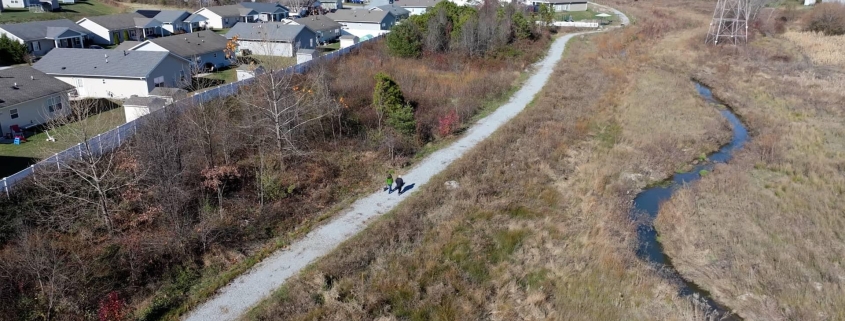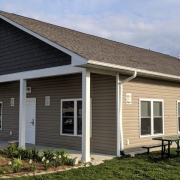Building Resilience
Habitat for Humanity’s Role in Restoring the French Broad River Floodplain
When we think about building a home, we often focus on the structure: sturdy walls, a safe roof, and a welcoming front porch. But the home’s surrounding environment plays a critical role in the health and safety of the people living there, especially when water is involved.
For the families at Dodd Meadows, our community in East Flat Rock, the river that runs alongside the neighborhood has long been part of the landscape. But until recently, it wasn’t necessarily a friendly neighbor.
Years of human intervention (straightening streams, draining wetlands, building too close to the banks, etc.) had stripped the river of its natural ability to manage flooding. The land couldn’t absorb heavy rain like it once did, and the water, with nowhere else to go, rushed downstream fast and high. After Hurricane Helene, floodwaters surged up to 15 feet above normal levels in some parts of the county. That kind of water doesn’t just disappear. It looks for somewhere to go.
That’s where the science of floodplain restoration comes in, and where our partnership with Conserving Carolina began.
A Partnership for Resilience
Working together, Henderson County and Thermal Belt Habitat for Humanity and Conserving Carolina have revitalized the stretch of river and floodplain beside Dodd Meadows. Instead of forcing the water to conform to manmade expectations, the project embraced the river’s natural behavior. The project involved restoring the winding path, reintroducing native plants to strengthen the banks, and carving out low-lying areas to give water a place to slow down and settle in heavy storms.
This isn’t just about beautifying the landscape, though that’s a lovely side effect. It’s about giving the river room to breathe so that neighborhoods like Dodd Meadows don’t bear the brunt of the next major storm.
A Path to Community and Nature
Today, the restored area doesn’t just serve an ecological purpose. It has become a gathering space for residents. A new walking path winds through the restored riverbank, offering neighbors a peaceful place to walk, relax, and connect with nature and each other.
As Linda Saturno, Executive Director of Henderson County Habitat for Humanity, shared with PBS North Carolina,
“Before Conserving Carolinas came in, this was not somewhere you wanted to go… [now] we have families that go down and walk on the trail. Children play in the creek. The mental health of children when they have green spaces is better as adults. It’s really a great surrounding of the community.”
That’s what we mean when we talk about building more than homes. At Henderson County and Thermal Belt Habitat, we believe a thriving community includes access to safe housing, green spaces, and the natural world. Thanks to this project, Dodd Meadows now has all three.
Looking Ahead
As climate change makes extreme weather more common, partnerships like this one become even more vital. The restoration at Dodd Meadows is just one example of how affordable housing, environmental responsibility, and strong local partnerships can work hand-in-hand.
By giving the river space, we’ve given families room to thrive.
For more information on the floodplain restoration efforts, you can read the full article by PBS North Carolina here: Bringing Back the Floodplain. You can also watch the PBS North Carolina report below.

 PBS North Carolina
PBS North Carolina




